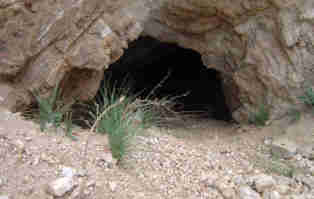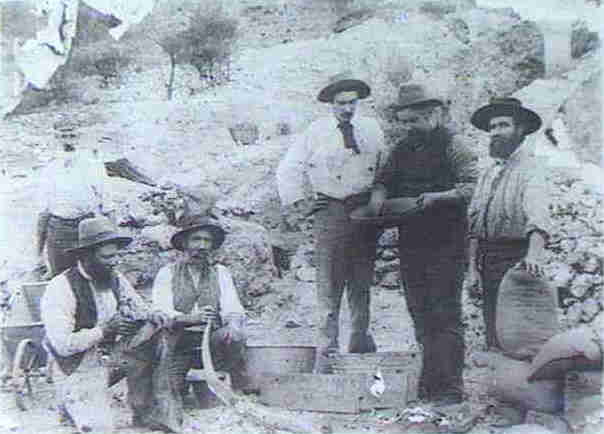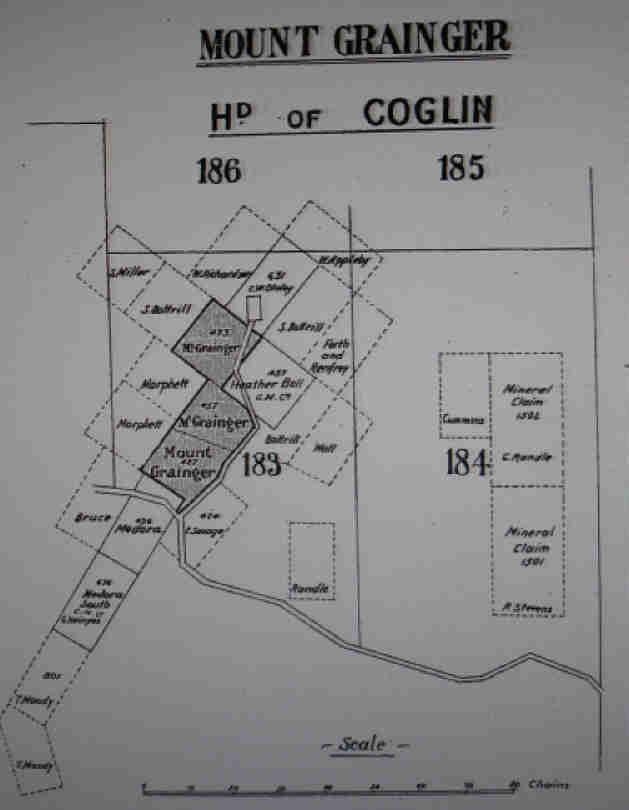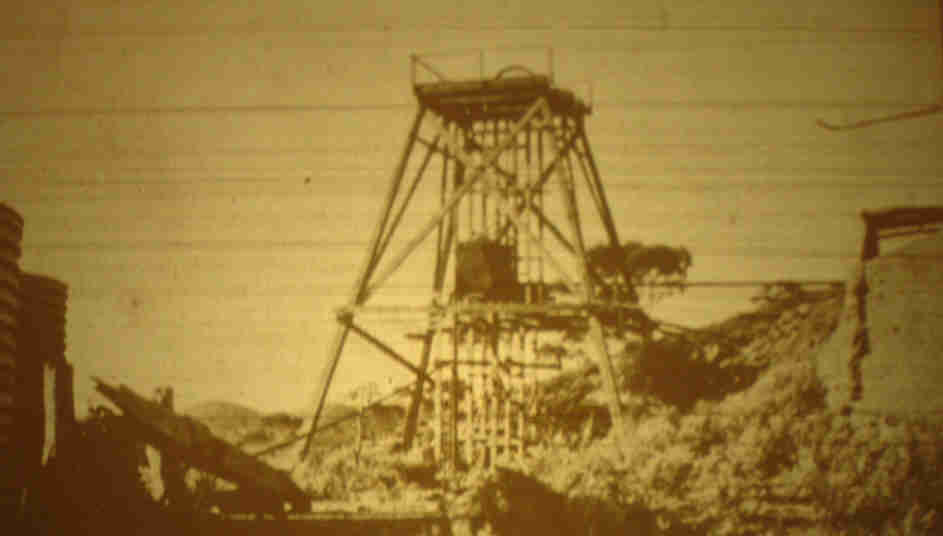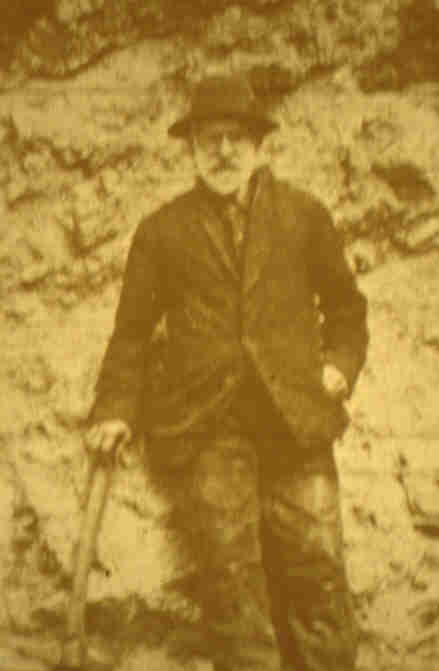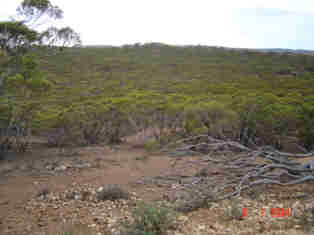


|

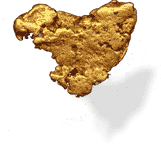
Mount Grainger GoldfieldPart II************
At the turn of the century Mount Grainger, about a kilometre from the mines started to look like a mining township. Hugh Sheridan of the Junction Hotel at Petersburg had opened a hotel which was managed by M Fogarty of the Lancelot Hotel. In 1901 a butcher store was opened and about fifty men were on the field, some had their families with them. Captain Jones and his family lived in an attractive residence on the hill. Some substantial house had been erected and the appearance of women and children gave the place quite a civilizing aspect. The main shaft of the New Mount Grainger mine had reached a depth of 184 feet by October and had three compartments. Poppet heads had been erected and a hauling engine and boiler placed in position under the direction of Captain Jones. Both the boiler and winding engine had been manufactured by Martin & Co of Gawler. H Kennedy of the Petersburg Cyanide Works testified that the ores delivered were of a rich quality. So far so good. The mine was inspected by John Heithersay and reported on by WH Matthews, government inspector, on 17 November 1900. Captain Henry Jones, who had been in charge for the last six months, came from Kalgoorlie. The mine was found to be worked in a first class manner. Most of the gold had come from the vertical engine shaft at a depth of seventy metres. Early February 1901 it was reported that some very rich ore had been located. Jones also had charge of the Medora and Heather Bell mines. By this time there were a large number of mines opened up on the field. Some of the better known were the Junction, the Wallaroo Junction discovered by George Forth, the Golden Junction, the Iron Clad, the New Mount Grainger, Heather Bell worked by an Adelaide company, the Jubilee, Applebys, Aureous, Stars and Stripes, Union Jack, the Dustholes, Medora and the Medora South.
Another attempt with poor results
The lease for the Medora mine, on section 295 had been granted to James McCarlin, butcher of Dawson and Christopher Coral Kyd on 1 October 1894. Work was started in 1895 and continued until March 1900, when its secretary applied for a three months suspension. Both William and John Heithersay had been part owners at different times. By May 1900, some 108 ounces of gold had been obtained from fifty-three tons of ore. Several new companies were floated or had started to work the Mount Grainger goldfield. The Medora South Gold Mining Company was incorporated on 9 December 1899 with Robert J Gully as secretary and the Mount Grainger Iron Clad Gold Mining Syndicate was incorporated on 8 November 1900 with an office at Ayr Street Jamestown. All were hopeful that their investments and much higher expectations would soon be realised. There was just one small problem. New gold mining companies floated to work this and other South Australian mining fields had once again competition from gold mining companies floated to work mines in the Northern Territory and Western Australia. They all sounded far bigger and better with untold dividends to be had, which werent coming from the Mount Grainger field, as yet. Towards the end of 1899 the Mount Barker Courier, in its supplement on mining in South Australia, wrote, The history of mining in South Australia does not afford pleasant reading. Excepting only the case of the flourishing copper mines, it has been a record of frequent disappointments, high hopes having been caused by rich finds to be dashed again when work had been started on it. The paper itself though had also high hopes and expectations and had published them on numerous occasions.
One more try 1900. (Courtesy SLSA)
However, rather than admitting that there did not seem to be too much gold in South Australia, it blamed the disappointments on the lack of capital when it said If all the South Australian money wasted on Wildcats in Western Australia had been put in local mines the industry would be flourishing. Finally it prophesised that one day South Australia would be a large gold producing country. In 1901 when Henry Rasmus, who had been educated at the Ulooloo School, visited the Mount Grainger field in his capacity as census collector, he found six families still living in tents, including the Cameron family from Scotland. Heithersay showed Rasmus the batteries and shafts and hoped that Rasmus would write an article about the field. Rasmus was too busy though and declined the opportunity.
Mount Grainger leases
According to Captain Henry Jones, the only thing required at the Mount Grainger goldfield was Capital. If this were forthcoming, he said, Mount Grainger would before long take rank as one of the best mining centres in Australia. On 29 July 1901, a new fifteen head battery, which had just been installed at the New Mount Grainger, was tried out. Steam was got up and the engine started by Heithersay and the whistle blown by Captain Jones son Quintin. A few weeks later the dewatering of the lower parts of the New Mount Grainer mine was started. The influx of water was now 18,000 litres a day and had to be kept in check. After fixing a few minor problems with the battery, crushing was started on 27 August. This would cause a revival of the somewhat languid interest which had lately taken in the mining here, it was hoped. The Golden Junction, which was worked by the original shareholders, had paid a dividend. Crushings of the Medora mine gave an average of 23 dwts to the ton with prospects looking very bright. With so many people on the field now and a large number with children, it was decided to ask the government to open a school. At the Mount Grainger Hotel, where Catherine Sheridon was now in charge, a meeting was organised with the object of forming a cricket club. After some debate it was agreed upon and QC Jones was elected captain, J Johnson vice-captain, John Heithersay vice-president, secretary and treasurer, M Fogarty president, James Shaw vice-captain and Henry Jones umpire. The main shaft of the New Mount Grainger had reached a depth of 370 feet in July 1901 with drives and crosscuts at the 120, 220, 290, 310 and 346 feet levels. It had two distinct parallel lodes of about 30 feet width. After the completion of the battery it employed some 70 men. However, after having worked its claim for some time, it was forced to ask for a suspension of the labour clause in 1902. Some of the options considered were to build a cyanide plant and sink a new shaft to obtain water for the battery. As a result of this stoppage, which lasted much longer than expected, many men left and by May the school and the shops had closed, leaving only the post office and hotel. In January 1903 Captain Henry Jones was also leaving to take charge of some mining ventures at Tarcoola. He was given a farewell social which was reported in great detail in the Petersburg Times a few days later. Part of it, which makes for some interesting reading, is reproduced in the next paragraphs. On Tuesday evening, January 13th, at the Oodlawirra Hotel, the residents of Mount Grainger and friends tendered a valedictory social to Captain Henry Jones who for two and a half years has had the management of the New Mount Grainger and other mines prior to his departure for Tarcoola. The large dining room was gaily decorated for the occasion. About forty guests sat down to dinner, and the genial host is to be congratulated on the excellent arrangements. Among those present were visitors from Petersburg, Jamestown, Ucolta, Nackara and Dawson. Host C Okely occupied the chair, on his right being the guest, Capt. Henry Jones and on his left J Heithersay. The Chairman submitted the toast and regretted that this, the most important toast of the evening, had been entrusted to such poor hands, but at the same time he regarded it as a compliment. He had had many dealings with Captain Jones since he had taken over the management of the New Mount Grainger Mine and he knew that he was voicing the sentiments of all present, as well as of the residents throughout the district, when he said that all regretted the captain's departure, and would much rather have tendered a social to welcome his return than to celebrate his departure (applause). The district could ill afford to lose their guest; in fact the State badly wanted more men like Captain Jones (applause). Their guest had had an up-hill contract since his advent to the field, especially when the shareholders expected to see as much returned as was expended. With a young mine like the New Mount Grainger such was impossible if the property was to be properly worked. He trusted that Capt. Jones would soon return to again take over the management of not only the Mount Grainger fields but those throughout the North East and from what he had been to understand he felt sure this would eventually be so (applause). If their guest could not make the Mount Grainger mines pay with his great knowledge of mining then he was convinced no one could. At one time Capt. Jones had had 1,000 men under his control and never was there a harder working man than he; their guest was a master, fellow workman and a mate and this he (the speaker) had proved (applause).
Mt Grainger mine 1929 He sincerely wished Captain and Mrs Jones and family health and all prosperity wherever they went (applause). J Heithersay said that although all present were extremely sorry that Capt. Jones was leaving the district, he was sure they would be somewhat consoled by the knowledge that their guest was taking over the management of mining properties at Tarcoola which would, in the near future, be a boon to the State. Jones had secured a gold medal in London for the ironstone from the Oodlawirra Flux Quarries, and this was an honour to the district (applause). At these quarries he had paid out 12.000 in wages, and he doubted whether residents were aware of this fact. At Mount Grainger there were lodes which, worked on the systematic scale submitted by Capt. Jones, would pay handsomely. Both the Oodlawirra Flux and Mount Grainger mines were now practically idle in consequence of the want of confidence on the part of investors. If there was not anything in the district he would not have visited it so often as he had done for years. The best milling facilities that could be offered were on the Mount Grainger field (applause). Capt. Jones had done a lot of work and although away he would manifest the same keen interest in the field that he had done in the past (applause). Captain Jones, on rising to respond, was accorded an ovation. He thanked them most heartily for their kindness in tendering him such a splendid send-off. He had never expected such hospitable treatment at their hands, as he had been such a short time in the district; but nevertheless he had made many friends and was departing with feelings of regret. He was leaving the Mount Grainger mines to take charge of some properties at Tarcoola. He hoped to return and take over the management of the north-eastern mines of the State, in the future prosperity of which he had such faith and confidence (applause). It only meant a slight expenditure to secure the returns so anxiously looked forward to by all interested in the New Mount Grainger, Medora, Aureous, Ironclad, Golden Junction, Dustholes, Jubilee, Kirkeek's Treasure and the Oodlawirra Flux and Mining Company's properties. He would leave for Tarcoola in about a fortnight's time. It was with great regret that he was departing, not only on account of those pleasant associations he had made, but because such valuable properties as those on the Grainger field were idle, so to speak, for the want of confidence on the part, of investors; these mines and others in the north-east would, in the near future, greatly benefit South Australia. He had heard that in a few weeks J Heithersay would be again visiting the fields and would be accompanied by a gentleman from WA who, it was expected, would largely invest in the mines. If it had not been for the energy put forward by Heithersay for years past he ventured to say that mining in the north-east would have been sadly neglected. In spite of much opposition Mr. Heithersay had pushed the local properties ahead, and his greatest opponents had been, he was sorry to say, residents of this and neighbouring districts. Despite this great opposition, however, Mr. Heithersay had succeeded and should receive the thanks of all for his zeal, perseverance, and energetic labour (applause). He hoped everyone in the district would assist Mr. Heithersay in every possible way, for by helping him they were benefitting themselves. The properties at Mount Grainger could be worked profitably on a large scale at a very low cost on account of the mining facilities, which would compare most favourably with those in any part of the world. With the facilities offered in the New Mount Grainger district, 3 dwts per ton paid working expenses and all over that amount could go to a reserve fund, or be paid in dividends. He again thanked all for their kindness and the flattering remarks uttered that evening and in conclusion hoped that the Mount Grainger field would be energetically taken up during his absence (applause). In March 1903 the New Mount Grainger mine was taken up on tribute by a party of six miners who worked at the 120 feet level. In April work was started on deepening the shaft and would be continued until a large supply of water was obtained. Some work was done during the next few years but by January 1906 the leases, which were then owned by J Heithersay of Unley, were cancelled. The battery had been sold by auction on 15 September 1905 but remained on site. A new start was made in October 1908 and everyone had high hopes, but once again very little materialised. In March 1908 Henry Jones, who had been appointed Inspector of Mines on 17 January 1907 after his stint as manager of the Tarcoola Blocks Mine, visited the field again. He concluded that if a water supply was available, the Mount Grainger, Medora and Dustholes could be worked very profitably. The New Mount Grainger was back in operation some time later and produced 113 ounces of gold in 1910. A good crushing was obtained from the Medora Mount Grainger Gold mining Syndicate of which J Heithersay was Secretary. On 7 October 1910 it was reported that ten tons of ore had realised more than 70 oz. of gold. It was considered a really first class result. In May 1912, after the overhaul of a 15-head crushing mill, Henry Jones reported that a start had been made with a cyanide plant to treat the tailings of the New Medora and Mount Granger Mine. When the field was inspected by Jack Lockhart in 1913, only two groups of leases were working. They were the New Medora and Mount Grainger Gold Mine and the Dustholes. The Mount Grainger had produced 715 ounces, the Medora South 458, Madora North 182 and the Dustholes 94 ounces.
The Golden Junction mine was taken up in July 1909 by T Murray who had previously worked on the Victorian and Western Australian goldfields. Although abandoned a few years ago Murray was willing to give it another try. According to him the Mount Grainger goldfield had been sadly neglected. There were only about 25 men at the field which could employ easily 800 to 1000 men if a small battery and cyanide plant was available. During 1914 a little work was carried out on the field. At the Golden Junction, Mount Grainger, Medora and Darley Day Dawn a few men were working but no stone was being crushed. During the second half of that year good results had been obtained from the Golden Junction were a company had been formed to erect a small battery to treat the ore. However, in September 1914 some questions were asked in Parliament about the amount of money the Government had advanced so far to the Mount Grainger Gold Mining Company. It came to a total of 1814.16.10. This included 77.7.7 to J Heithersay of the Medora-Mount Grainger lease, 344.2.2 to the Medora-Mount Grainger Gold Mines, 1000 to the New Medora and Mount Grainger Gold Mines and another 393.7.1 to the New Mount Grainger Gold Mines. Two years later only a few tributers were working on the Medora and Mount Grainger Gold mine and a small parcel of ore treated at Peterborough in 1917 realised a little over 30. At the close of 1925 a government subsidised prospecting party reported the discovery of a gold bearing formation in a previously unworked area. R and J Jones, the discoverers, were giving it a fair go but only had low returns and saw no reason for further prospecting. It was sold and became the Gangells Gold Mine in 1930. Gangell didnt have much luck. The mine didnt pay and to make matters worse while he and his wife were in Adelaide in March, his house at the mine was destroyed by fire. In November 1929 some more gold was discovered by Harry Jones, who had lived on the field for many years and in 1934 the field was once more visited by some Adelaide identities, among them WA Crouch and AC Wells, but nothing came of it. Many other attempts have been made since then to work the Mount Grainger goldfield but none have been able to discover more prominent lodes or make a profit of the existing ones.
All quiet once again
*** If you would like to find out more,
|
